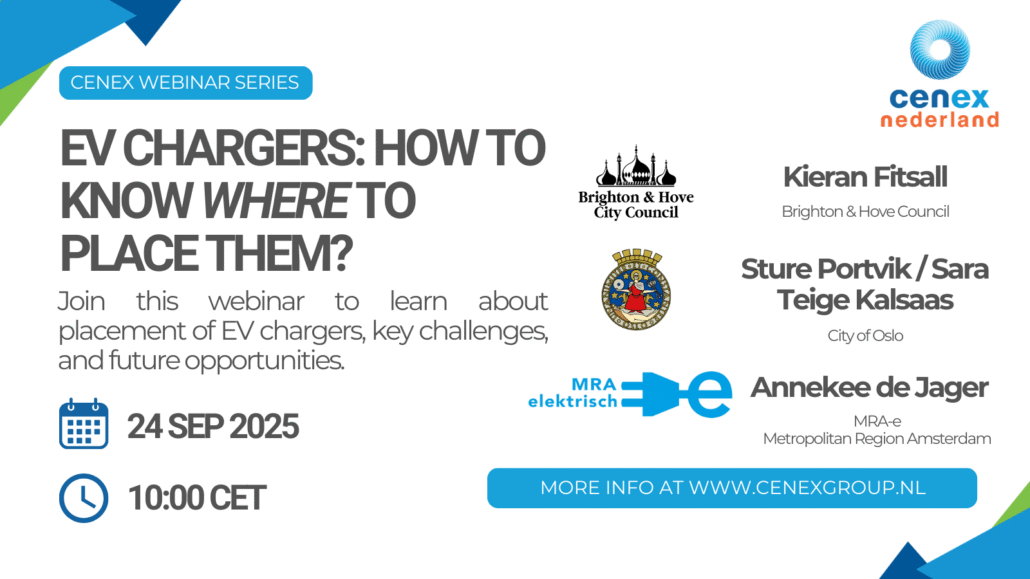EV Charger Placement: Key Insights from European Cities Webinar
Our recent webinar “EV Chargers: How to Know Where to Place Them” brought together three leading European cities to share their proven strategies for electric vehicle charging infrastructure placement. The insights from Oslo, Brighton & Hove, and the Netherlands region offer valuable lessons for cities worldwide navigating the EV transition.
Oslo: Leading the Way with 94% EV Market Share
Speakers: Sarah Teige Kalsaas & Sture Portvik
Oslo represents one of the world’s most successful EV adoption stories, with electric vehicles accounting for 94% of new car sales and targeting 100% by 2030. The city’s approach demonstrates how to scale charging infrastructure to meet high adoption rates.
Key Achievements:
- 140,000 electric vehicles in a city of 720,000 citizens
- 2,600 AC chargers strategically placed across the city
- 70,000 private charging points supported through subsidy schemes
- 40% target utilization rate (currently at 20% average)
Strategic Approach:
Oslo employs a three-pronged strategy:
- Subsidies for private companies to install chargers on private grounds
- Joint venture support for fast charging DC infrastructure
- City-owned curbside charging network for public access
Data-Driven Decision Making:
The city uses sophisticated analytics to optimize charger placement:
- Color-coded usage maps showing charging intensity by location
- 5.6-hour average charging sessions with one session per week per vehicle
- Focus on 30% of households without private parking for public charging
- Commercial fleet considerations: Taxis charge twice daily, vans 2.5 times per week
Holistic Urban Planning:
Oslo’s success stems from integrating EV infrastructure with broader urban policies:
- Car-free city center with toll gates favoring electric vehicles
- Public transport prioritization while supporting necessary EV charging
- Commercial fleet electrification with zero-emission requirements
Brighton & Hove: Accessibility and Community Engagement
Speaker: Kieran Fitzel
Brighton & Hove demonstrates how UK cities can overcome regulatory challenges while creating accessible charging infrastructure that serves all residents.
Current Status:
- 280,000 population with 120,000 registered vehicles
- 3% currently electric (targeting 64,000 EVs by 2035)
- 500 public on-street chargers expanding to 6,000 in 6 years
- 50% of households lack off-street parking
Strategic Initiatives:
- Three 15-year contracts with different operators (Blink, Chargy, Believe)
- £3 million government funding from LEVI (Local Electric Vehicle Infrastructure Fund), where Cenex UK developed NEVIS for
- Fully funded team by Department for Transport
Site Selection Criteria:
Brighton uses a comprehensive four-element approach:
- Demand: Data-driven analysis of charging needs
- Suitability: Technical and physical feasibility
- Equitability: Ensuring fair access across all communities
- Usage: Monitoring and optimization of existing infrastructure
Accessibility Focus:
- 80% of residents within 3-minute walk of charging (currently 83% within 5 minutes)
- Price disparity awareness: 7p/kWh home charging vs 55p/kWh public charging
- Community engagement: EV rally events and test drive opportunities
- Accessibility standards: Following PAS 1899 guidance for disabled users
Future-Proofing Strategy:
- New developments include charging infrastructure provisions
- Cross-departmental collaboration with planning and transport teams
- Developer partnerships for integrated charging solutions
Netherlands Regional Approach: Data-Driven Expansion
Speaker: Anneke de Jager (MRA Electric)
The Metropolitan Region of Amsterdam Electric showcases how regional coordination can optimize charging infrastructure across multiple municipalities.
Regional Scope:
- 80 municipalities and 3 provinces in northwestern Netherlands
- 16,500+ public charging points in contracts
- 70% of households lack private driveways
- 1 charger per 8 EVs ratio across the region
Data-Driven Decision Making:
MRA Electric uses sophisticated analytics to guide expansion:
- National charging session database for comprehensive decision making
- Two key performance indicators:
- Occupancy rate >40% for 3 consecutive months
- Electricity usage >1,000 kWh per month for 3 consecutive months
- 150-meter walking distance between charging points
Innovation and Efficiency:
- “Plug and Save” program: Lower prices for off-peak charging
- Workflow tool for collaboration with municipalities and operators
- Data quality management using OCPI standards
- Economies of scale through large regional contracts
Key Insights:
- Transparency in methods for public understanding
- Start small, scale up approach to data-driven planning
- Harmonized user experience across municipalities
- Contractual data access ensures long-term planning capability
Common Themes and Key Takeaways
1. Data-Driven Decision Making
All three cities emphasized the critical importance of using real usage data to inform charging infrastructure placement. This includes:
- Utilization monitoring and performance analytics
- Demographic and traffic pattern analysis
- Grid capacity assessments and smart charging optimization
- Real-time adaptation based on usage patterns
2. Accessibility and Equity
Ensuring charging access for residents without private parking emerged as a universal priority:
- On-street charging solutions for overnight charging
- Walking distance optimization (3-5 minute maximum)
- Community charging hubs and workplace programs
- Financial accessibility and incentive programs
3. Holistic Urban Planning
Successful EV infrastructure requires integration with broader urban policies:
- Public transport prioritization alongside EV support
- Car-free zones and congestion management
- Commercial fleet electrification requirements
- Cross-departmental coordination for comprehensive planning
4. Public-Private Partnerships
All cities leveraged both public investment and private sector expertise:
- Government funding for initial infrastructure development
- Private operator contracts for ongoing management
- Subsidy schemes for private charging installations
- Long-term contracts ensuring sustainable operations
5. Future-Proofing and Scalability
Planning for long-term growth and technological changes:
- Modular infrastructure that can adapt to demand
- Smart charging integration for grid optimization
- Technology standards ensuring interoperability
- Scalable data systems for ongoing optimization
Lessons for Other Cities
For Cities Starting Their EV Journey:
- Begin with data collection – establish baseline usage patterns
- Focus on accessibility – ensure equitable access for all residents
- Plan holistically – integrate with broader urban planning goals
- Engage stakeholders – involve communities in planning processes
For Cities Scaling Existing Infrastructure:
- Use performance data – optimize based on real usage patterns
- Coordinate regionally – share resources and best practices
- Maintain flexibility – adapt to changing technology and demand
- Ensure transparency – communicate methods and decisions clearly
The Path Forward
The insights from these three cities demonstrate that successful EV charging infrastructure requires more than just technical solutions. It demands strategic thinking, data-driven decision making, and a commitment to serving all residents equitably.
As Europe continues its transition to electric mobility, these proven approaches offer a roadmap for cities worldwide. The key is to start with data, focus on accessibility, and integrate charging infrastructure with broader urban planning goals.
The future of urban mobility is electric, and these cities are showing us how to make it work for everyone.
This webinar is part of Cenex’s ongoing commitment to supporting European cities in their transition to sustainable mobility. For more insights and best practices, follow our webinar series and join the conversation about the future of urban electric vehicle infrastructure.




